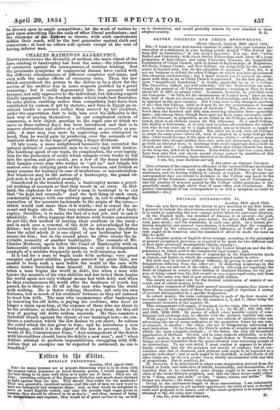DECIMAL COINAGE.—N0. II.
London, 24th April 1854. Sue—As you have done me the favour to give insertion to my first letter, I proceed to submit the observations reserved for a second. Their sole aim is to assist in rendering the new coinage better fitted for universal adoption. In the English mint, the standard of fineness is at present—for gold, 11-12, 440-480, or 91j per cent, pure metal ; for silver, 444-480, or 921 per cent, pure metal ; and the remainder, in each case, alloy. In a system pro- fessing simplicity and general convenience, it is evident that the complica- tion caused by the unnecessary fractional difference of 4-480 or 5-6 per cent ought to be removed, and the standard of silver be made the same as that for gold.
In a complete system of English silver coinage, according to the principles at present recognized, provision is required to be made for two different and at Srst sight seemingly incompatible objects, namely— First, For the exaction of seignorage in the United Kingdom and the De- pendencies in which gold is the commercial legal tender; and, Secondly, For the non-exaction of seignorage in the Dependencies (such as Canada and India) in which the commercial legal tender is silver. But both may be attained without difficulty, by giving to one set of coins designations differing from the other set ; by deducting seignorage in the weight of one set and not of the other ; and by allowing (or requiring) the Bank of England to receive silver bullion of standard fineness, for the pur- pose of being coined into the full-weight or non-seignoraged coins, and those only, in the same way that it now receives gold bullion. The simple and proper rule for the decimal subdivision of monies of ac- count, and of coined monies, is this.
An integer composed of 1000 parts must of necessity comprise four places of figures. In accounts, each of these four places ought to represent a money of account distinguished by a specific designation. In coined money, the coins corresponding to each of the four monies of account ought to be multiplied by the numbers 1, 2, and 5; these being the component elements of the number 10. This arrangement will supply, if required, twelve coins, (the exact number now in use,) of the respective values of 1, 2, 5 ; 10, 20, 50 ; 100, 200, 600 ; and 1000, 2000, 5000. By means of which every possible variety of com- bination and exchange may be effected with the greatest rapidity and ease. With regard to nomenclature, there are two schools of opinion,—the one advocating the use of terms indicative of the proportion borne by one coin, or measure, to another ; the other, the use of designations conveying no such indication. Of the former, the French system of weights and measures affords the most complete example ; of the latter, the racy old household appellatives of Holland. Precise, and in some respects admirable, as is the French system, it is probable that to Anglo-Saxon or Teutonic ears few things are more distasteful than the quasi-classical ever-recurring sounds of its terminology. To my own mind, I must confess it appears to be abun- dantly evident, that for the 'purposes not merely of euphony but of con- venience also and of clearness, eireh separate coin ought to be regarded as a separate individual ; and as such ought to be identified, as individuals of all other kinds are, by its own proper name, wholly unconnected with any idea of proportions. But de gustibus, &c. If, however, it be determined to adopt some designation derived from the French or Latin, and indicative of tenths, hundredths, and thousandths, it is manifest that, to be consistent, some change ought to be made in one or other of the terms hitherto proposed, and that the three terms ought either to be " dims, cents, and mils," or else, " dimes, centes, and milles." The former are shorter ; the latter, less inelegant. Owing to the unforeseen length of these observations, I am reluctantly compelled to postpone to yet another opportunity the table of new or decimal coins now proposed to be issued, and of the values proposed to be temporarily attached to the old coins now extant.
I am, Sir, your obedient servant,
H.


























 Previous page
Previous page